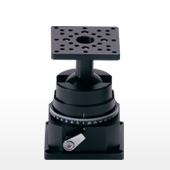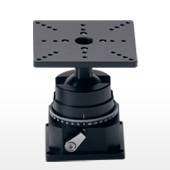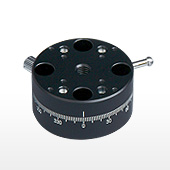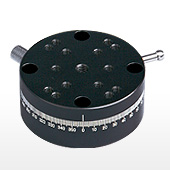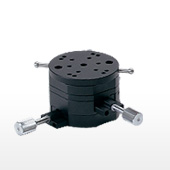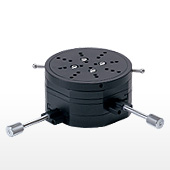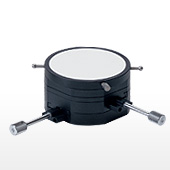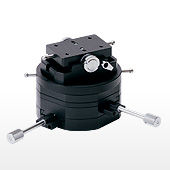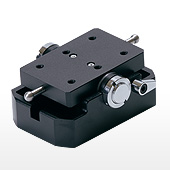Gate turning stage -Complete flexibility in positioning (Maximum 180° bending, 360° rotation )-
Spherical configuration of the main moving parts allows operation that was not possible with convention products. The unique concept of this stage features maximum 180° bending and 360° rotation, allowing complete flexibility in positioning.
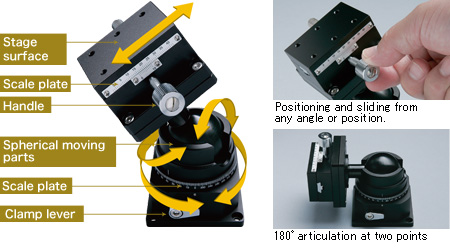
Examples of RC-60 and XJK-60 combination
Combination with a dovetail stage adds gate turning functionality to straight forward sliding, enabling positioning from any attitude.
* Loosen the set screw and rotate the scale ring to set the reference position to 0.
| Model | Stage surface (mm) | Travel (°) | Load capacity N (kgf) | Minimum scale reading (°) | Weight (kg) |
|---|---|---|---|---|---|
| RC-60 | 60 x 60 | 180° bending, 360°, allowing complete flexibility | 39.2 (4) | 1° | 0.5 |
| RC-90 | 90 x 90 | 180° bending, 360°, allowing complete flexibility | 39.2 (4) | 1° | 0.57 |
* Material: stage body: aluminium alloy, surface treatment: matt black alumite
| Grind | Uneveness | Gap | Backlash | Play | |
|---|---|---|---|---|---|
| MIRUC products | ◎ | ◎ | ◎ | ◎ | ◎ |
| Overseas product | △ | × | △ | × | × |
- ■Gori
- When turning the handle, there is a rough feeling and there is no smoothness.
This often happens when meshing of the rack and pinion is too tight. - ■Mura
(Unevenness) - This is being heavy and light like wave for every stroke.
This often happens when the mesh between the rack and pinion is too weak. - ■Kishimi
(Crease) - It is a sense of incongruity that when sliding the stage to one side, it feels stuck and becomes heavy and when sliding the stage to other side, it becomes lighter.
- ■Gata
(Backlash) - This is a subtle feeling of backlash and play due to poor sliding contact of male and female dovetail.
- ■Asobi
(Play) - This is clearance between gear contact surfaces intentionally provided in the direction of motion. By suppressing this gap as much as possible, smooth sliding can be made possible without backlash.
Rotational stage -360° Rotation-
This stage can be smoothly rotated manually through 360°. It can even be used upside down.
| Model | Stage surface (mm) | Travel (°) | Eccentricity (mm) | Load capacity N (kgf) | Minimum scale reading (°) | Weight (kg) |
|---|---|---|---|---|---|---|
| KTS-40 | φ 40 | 360° | 0.05 | 49.0 (5) | 2° | 0.06 |
| KTS-60 | φ 60 | 360° | 0.05 | 68.6 (7) | 1° | 0.2 |
* Material: stage body: aluminium alloy, surface treatment: matt black alumite
* Accessory screws M4 x 8 Hexagonal bolts – 4 SUSXM7
| Grind | Uneveness | Gap | Backlash | Play | |
|---|---|---|---|---|---|
| MIRUC products | ◎ | ◎ | ◎ | ◎ | ◎ |
| Overseas product | △ | × | △ | × | × |
- ■Gori
- When turning the handle, there is a rough feeling and there is no smoothness.
This often happens when meshing of the rack and pinion is too tight. - ■Mura
(Unevenness) - This is being heavy and light like wave for every stroke.
This often happens when the mesh between the rack and pinion is too weak. - ■Kishimi
(Crease) - It is a sense of incongruity that when sliding the stage to one side, it feels stuck and becomes heavy and when sliding the stage to other side, it becomes lighter.
- ■Gata
(Backlash) - This is a subtle feeling of backlash and play due to poor sliding contact of male and female dovetail.
- ■Asobi
(Play) - This is clearance between gear contact surfaces intentionally provided in the direction of motion. By suppressing this gap as much as possible, smooth sliding can be made possible without backlash.
Thin XY rotational stage -multi-function-
Almost 30% thinner than conventional combinations, this is a disk-shaped, compact and multi-function stage. Rotation and sliding action along X and Y axes.
* XYR-90 side has different stages, making it ideal for applications such as the following.
| Model | Stage surface (mm) | Travel (mm) | Travel per rotation (mm) | Travel precision (μm) | Load capacity N (kgf) | Weight (kg) | |
|---|---|---|---|---|---|---|---|
| Straightness | Degree of parallelism during operation | ||||||
| XYR-60 | φ 60 | ± 21 360° | 4.2 | 30 | 30 | 34.3 (3.5) | 0.39 |
| XYR-90A | φ 90 | ± 35 360° | 4.2 | 30 | 30 | 34.3 (3.5) | 0.88 |
| XYR-90B | φ 90 | ± 35 360° | 4.2 | 30 | 30 | 34.3 (3.5) | 0.84 |
| XYR-90C | φ 90 | ± 35 360° ± 20° | 4.2 | 30 | 30 | 29.4 (3) | 1.03 |
* Material: stage body: aluminium alloy, surface treatment: matt black alumite
| Grind | Uneveness | Gap | Backlash | Play | |
|---|---|---|---|---|---|
| MIRUC products | ◎ | ◎ | ◎ | ◎ | ◎ |
| Overseas product | △ | × | △ | × | × |
- ■Gori
- When turning the handle, there is a rough feeling and there is no smoothness.
This often happens when meshing of the rack and pinion is too tight. - ■Mura
(Unevenness) - This is being heavy and light like wave for every stroke.
This often happens when the mesh between the rack and pinion is too weak. - ■Kishimi
(Crease) - It is a sense of incongruity that when sliding the stage to one side, it feels stuck and becomes heavy and when sliding the stage to other side, it becomes lighter.
- ■Gata
(Backlash) - This is a subtle feeling of backlash and play due to poor sliding contact of male and female dovetail.
- ■Asobi
(Play) - This is clearance between gear contact surfaces intentionally provided in the direction of motion. By suppressing this gap as much as possible, smooth sliding can be made possible without backlash.
Tilt stage -±20° Tilt (stage)-
The tilt stage is a simple ± 20° stage. With a seesaw tilt action, it can be fixed in any position with a Clamp lever.
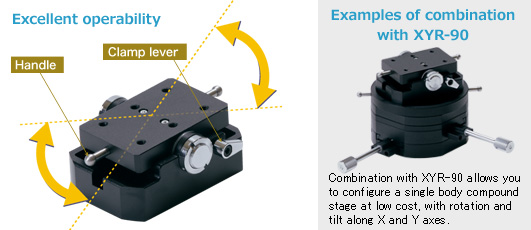
| Model | Stage surface (mm) | Travel (°) | Load capacity N (kgf) | Weight (kg) |
|---|---|---|---|---|
| AIC-60 | 40 x 60 | ± 20° | 29.4 (3) | 0.22 |
* Material: stage body: aluminium alloy, surface treatment: matt black alumite
| Grind | Uneveness | Gap | Backlash | Play | |
|---|---|---|---|---|---|
| MIRUC products | ◎ | ◎ | ◎ | ◎ | ◎ |
| Overseas product | △ | × | △ | × | × |
- ■Gori
- When turning the handle, there is a rough feeling and there is no smoothness.
This often happens when meshing of the rack and pinion is too tight. - ■Mura
(Unevenness) - This is being heavy and light like wave for every stroke.
This often happens when the mesh between the rack and pinion is too weak. - ■Kishimi
(Crease) - It is a sense of incongruity that when sliding the stage to one side, it feels stuck and becomes heavy and when sliding the stage to other side, it becomes lighter.
- ■Gata
(Backlash) - This is a subtle feeling of backlash and play due to poor sliding contact of male and female dovetail.
- ■Asobi
(Play) - This is clearance between gear contact surfaces intentionally provided in the direction of motion. By suppressing this gap as much as possible, smooth sliding can be made possible without backlash.
